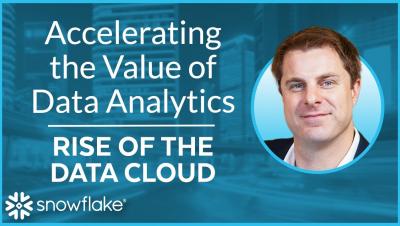Systems | Development | Analytics | API | Testing
Snowflake
Top 7 Trends in Marketing Analytics for 2021
Powered by advances in machine learning, marketing analytics delivers more bottom-line impact with each passing year. It enables organizations to improve the targeting of ads and other content, optimize their ad spend through advanced marketing attribution, increase customer lifetime value, reduce churn, and more. While technology is making granular targeting and measurement possible, marketers are also doubling down on measures to ensure consumer privacy and data governance in their initiatives.
Behind the Data Cloud Episode 2: Steven Segal
Investment in Knoema Puts Global Public Data Sets At Snowflake Users' Fingertips
The world is rich with publicly available data sets that can provide immense value to businesses, in areas as diverse as economics, health, agriculture and transportation. But the data is highly fragmented, stored in different formats and databases around the world, making it very hard for businesses to consume and monetize.
Unlocking Value by Going All-in On The Data Cloud
Snowflake met with Mark Stange-Tregear, Vice President of Analytics for Rakuten Rewards, and Andrew Parry, Vice President of IT Application Development for Office Depot, at Data Cloud Summit 2020. The Data Cloud is unlocking new ways of delivering products and services to customers, managing supply chains, and collaborating globally. Rakuten Rewards and Office Depot are going “all- in” on the Snowflake Data Cloud to transform their businesses. Q. How does data affect your business?
Data's Impact on Business & Technology | Part 2 | Snowflake Inc.
How Data Robot Automates Artificial Intelligence | Part 1 | Snowflake Inc.
405% 3-year ROI Procuring Snowflake Through AWS Marketplace: New Forrester TEI Study
Snowflake is delighted to share the findings of a new Forrester Consulting Total Economic Impact™ (TEI) study that examines the potential return on investment for organizations that procure Snowflake through Amazon Web Services (AWS) Marketplace and then use Snowflake as a core part of your application’s architecture. We commissioned the study in partnership with AWS.
Managing Snowflake's Compute Resources
This is the 3rd blog in our series on Snowflake Resource Optimization. In parts 1 and 2 of this blog series, we showed you how Snowflake’s unique architecture allows for a virtually unlimited number of compute resources to be accessed near-instantaneously. We also provided best practices for administering these compute resources to optimize performance and reduce credit consumption.








